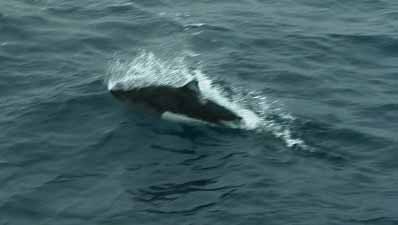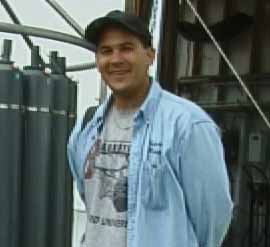WHAT'S NEW:
BACKGROUND:
Mission
Project Description
Cruise Plans:
Participants
Technology (ROV, ships, etc.)
Future Plans
Results:
1998 NeMO Cruise
Axial 1998 "Eruption"
Logbook
June 20, 1999
June 20, 1999
Contents:
- News from Thompson
- News from Wecoma
- Participant Perspective
- Logbooks from Teacher at Sea
- Question/Answer from shore to sea
Thompson Science Report
Not available.
Wecoma Science Report
See teacher's log below.
Listing of all Science News postings
Life at Sea: Participant Perspective
Not available today.
Listing of all Perspectives postings
Teacher At Sea Logbook
Day 5, Sunday 6/20/99
This morning the lab was active with the completion of a "Tow-Yo". This one crossed over the caldera, or cone of the Axial Volcano at a 90 degree angle from the first. This method allows the scientists to have a clear understanding of the spread of the plume. The map table is very colorful with the location of the ship and the trailing CTD package in contrasting colors (example: yellow, blue or green and red) clearly marking each along the cruise line. Each rising and lowering of the CTD is marked with the time and depth sounded on a log sheet. Eugene Burger, a technician from NOAA/PMEL and Brian Laubner, a junior midshipmen at the U.S. Naval Academy have been busy most of the night and early morning recording the ships trackline on the map.
With each sample taken we gain a clearer understanding of the location of the volcanic plume in the water column. My understanding of the relationship among the data collected is beginning to make more sense. This exploration can be interpreted in many ways. Each scientist aboard has individual needs for profiles and the wide variety of samples to be utilized in the labs on the scientists' return.
 Dall's
porpoise again play along the side of our vessel in the early evening.
They feed off the stern on Saurimi (similar to herring, but pelagic open
ocean, 8"-10" long) drawn in by the ships lights. You could hear the clicking
communication and/or sonar of the dolphin when standing on the deck. It
was 1:30 am and their performance was a welcome change of pace.
Dall's
porpoise again play along the side of our vessel in the early evening.
They feed off the stern on Saurimi (similar to herring, but pelagic open
ocean, 8"-10" long) drawn in by the ships lights. You could hear the clicking
communication and/or sonar of the dolphin when standing on the deck. It
was 1:30 am and their performance was a welcome change of pace.
This is an interesting adventure! Tomorrow I am sure will bring even more....
Fair seas,
Ms. Deck
Teacher log #1 Sunday 6/20/99 Happy Father's Day
Logbook of all Teacher At Sea postings
 At long last,
final preparations are being made for us to leave Victoria and head out
to sea. Scientists have set up, checked and rechecked equipment, run baseline
tests and tied down their equipment. The remotely operated submersible,
affectionately known as ROPOS, got
its first test in the water from the dock at 11:45 a.m. and managed to
checkout OK with little trouble. ROPOS will get another deeper test later
tonight as we move out to sea. We are coming up to the no turning back
point for those of us who still are not sure why we are here (like me).
Things that we will be writing to you about from this voyage will include,
remotely operated vehicles (ROVs) and ROPOS, the Cage, tethers and umbilicords,
and special
deep water cameras and other assorted equipment that will be attached
to ROPOS. While waiting on board over the past 24 hours, I have met many
interesting individuals whom you will meet later and have discussed research
plans with a number of the scientists. Some of the equipment I have been
able to observe include the CTD
Rossette sampler, osmotic
sampler and osmotic analyzer. These last two are both designed for
long term deployment on site. The sampler was used last year and has an
incredibly simple design while the analyzer is new and will be tested
early in the trip and then be retrieved for data collection. If it works
well it will be deployed again for a longer stay on the bottom. More to
come on both these unique tools. We have just been given the call for
all ashore who are going to shore so its departure time at last!! Have
a great time following the cruise of the
At long last,
final preparations are being made for us to leave Victoria and head out
to sea. Scientists have set up, checked and rechecked equipment, run baseline
tests and tied down their equipment. The remotely operated submersible,
affectionately known as ROPOS, got
its first test in the water from the dock at 11:45 a.m. and managed to
checkout OK with little trouble. ROPOS will get another deeper test later
tonight as we move out to sea. We are coming up to the no turning back
point for those of us who still are not sure why we are here (like me).
Things that we will be writing to you about from this voyage will include,
remotely operated vehicles (ROVs) and ROPOS, the Cage, tethers and umbilicords,
and special
deep water cameras and other assorted equipment that will be attached
to ROPOS. While waiting on board over the past 24 hours, I have met many
interesting individuals whom you will meet later and have discussed research
plans with a number of the scientists. Some of the equipment I have been
able to observe include the CTD
Rossette sampler, osmotic
sampler and osmotic analyzer. These last two are both designed for
long term deployment on site. The sampler was used last year and has an
incredibly simple design while the analyzer is new and will be tested
early in the trip and then be retrieved for data collection. If it works
well it will be deployed again for a longer stay on the bottom. More to
come on both these unique tools. We have just been given the call for
all ashore who are going to shore so its departure time at last!! Have
a great time following the cruise of the
Questions & Answers
![]() Send Your Question to NeMO
Send Your Question to NeMO
(oar.pmel.vents.webmaster@noaa.gov)
![]() Back to Calendar
Back to Calendar